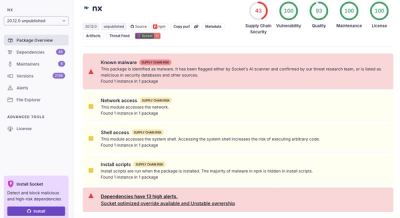
Security News
/Research
Wallet-Draining npm Package Impersonates Nodemailer to Hijack Crypto Transactions
Malicious npm package impersonates Nodemailer and drains wallets by hijacking crypto transactions across multiple blockchains.
@shiftbrainstd/polyrhythm-typography
Advanced tools
Polyrhythm Typography Module
A library to create and manage beautiful and consistent typographic rules for your project. Distributes as a Sass and JavaScript module
This documentation refers to the Sass APIs. To use the library with JavaScript read the documentation here.
npm install @shiftbrainstd/polyrhythm-typography
First of all setup the project’s typefaces as a map where each key identifies the typeface and its value has the following properties:
family {list} - List of font family strings (required)style {string} - font-style valueweight {string} - font-weight valueExample:
$typefaces: (
"sans": (
"family": ("Helvetica Neue", "Arial", sans-serif),
"style": normal,
"weight": 400,
),
// ...,
);
Then define some CSS breakpoints. polyrhythm-typography comes with the following values:
$mq-breakpoints: (
"xs": 0,
"sm": 36em, // 576px
"md": 48em, // 768px
"lg": 64em, // 1024px
"xl": 80em, // 1280px
);
polyrhythm-typography uses Sass modules. To import and setup it use the following syntax:
@use 'polyrhythm-typography' as pt with (
$typefaces: $typefaces,
$mq-breakpoints: $mq-breakpoints
);
.component__title {
@include pt.textstyle(/* configuration */);
}
textstyleThe module exposes a textstyle mixin accepting a configuration map with the following properties:
| name | type | description |
|---|---|---|
| typeface | string | Typeface id as defined in $typefaces |
| sizes | list | A list containing a scalar value for the font size (-2 to 4) and its line-height (0 to 4) |
| case | string | Font case. Supported values are "all-lowercase", "all-caps", "small-caps" and "all-small-caps" |
| tracking | number | Letter spacing multiplier |
| breakpoints | map | Breakpoint modifiers settings. (see below) |
Example:
$textstyle-body: (
typeface: "sans",
sizes: (0, 3),
tracking: 50,
);
.component__body {
@include pt.textstyle($textstyle-body);
}
The default values provided by the library should work pretty fine to enforce a consistent modular scale system across the project.
Anyway, you can can provide your own customized values in the module configuration:
$font-sizes: (
2: 2rem,
1: 1.5rem,
0: 1rem,
-1: 0.5rem,
);
/// Default line heights
/// @type Map
$line-heights: (
4: 2,
3: 1.75,
2: 1.5,
1: 1.25,
0: 1,
);
@use "polyrhythm-typography" as pt with (
// ...
$font-sizes: $font-sizes,
$line-heights: $line-heights,
);
$textstyle-body: (
sizes: (1, 3)
);
.component__body {
@include pt.textstyle($textstyle-body);
/*
outputs:
font-size: 1.5rem;
line-height: 1.75rem;
*/
}
By default polyrhythm-typography uses an internal function (aka type scaler) that matches numeric size scales with the corresponding values on the $font-sizes and $line-heights maps.
If you need more control over the calculation process, you can provide your custom type scaler function.
A type scaler function receives a list with two numeric values (font-size and line-height) and must return a list with valid CSS font-size and line-height (optional) values.
Here is an example:
// _helpers.scss
@use "sass:list";
// $input: (1, 3)
@function my-scaler($input) {
$sizes: ();
@each $i in $input {
$sizes: list.append($sizes, $i * 10px);
}
@return $sizes; // (10px, 30px)
}
To instruct polyrhythm-typography to use your custom type scaler pass it as the module configuration’s $type-scaler option:
// main.scss
@use "sass:meta";
@use "helpers";
@use "polyrhythm-typography" as pt with (
//... other configurations
$type-scaler: meta.get-function("my-scaler", $module: "helpers")
);
Note: $font-sizes and $line-heights configuration options will not have any effect when using a custom type scaler function.
To override certain configuration values for a given breakpoint set the breakpoints property:
$textstyle-body: (
typeface: "sans",
sizes: (0, 3),
tracking: 50,
breakpoints: (
md: (
// change the font size at md
sizes: (2, 3)
),
)
);
npm start
npm run test
👤 Shiftbrain Standard Design Unit (https://standard.shiftbrain.com/)
Contributions, issues and feature requests are welcome!
Feel free to check issues page.
Copyright © 2019 Shiftbrain Standard Design Unit.
This project is MIT licensed.
This README was generated with ❤️ by readme-md-generator
FAQs
Polyrhythm Typography Module
The npm package @shiftbrainstd/polyrhythm-typography receives a total of 3 weekly downloads. As such, @shiftbrainstd/polyrhythm-typography popularity was classified as not popular.
We found that @shiftbrainstd/polyrhythm-typography demonstrated a not healthy version release cadence and project activity because the last version was released a year ago. It has 3 open source maintainers collaborating on the project.
Did you know?

Socket for GitHub automatically highlights issues in each pull request and monitors the health of all your open source dependencies. Discover the contents of your packages and block harmful activity before you install or update your dependencies.

Security News
/Research
Malicious npm package impersonates Nodemailer and drains wallets by hijacking crypto transactions across multiple blockchains.

Security News
This episode explores the hard problem of reachability analysis, from static analysis limits to handling dynamic languages and massive dependency trees.

Security News
/Research
Malicious Nx npm versions stole secrets and wallet info using AI CLI tools; Socket’s AI scanner detected the supply chain attack and flagged the malware.